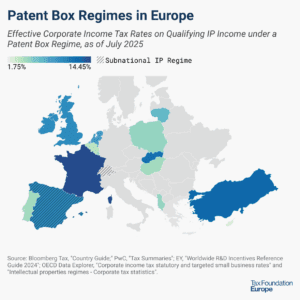
Discrimination vs. Neutrality: A Case Study in the Middle of a Trade War
6 min readBy: ,Trade tensions have escalated globally due to the implementation of various taxes perceived as discriminatory, leading to retaliatory measures and potential trade wars. A significant point of dispute is the digital services taxA tax is a mandatory payment or charge collected by local, state, and national governments from individuals or businesses to cover the costs of general government services, goods, and activities. (DST) adopted by several countries, which unfairly targets US digital companies. Recently, the US doubled down on threats to double tax rates for foreign nationals and companies if US citizens or corporations are being subjected to “discriminatory or extraterritorial taxes” under the laws of any foreign country. Additionally, US President Donald Trump has announced his intention to impose reciprocal tariffs on foreign countries that use a value-added tax (VAT), which he considers “far more punitive than a tariff.”
President Trump is incorrect about VATs, even if he is right to attack DSTs.
Given the confusion, we explain the principle of tax neutrality and describe what makes a policy discriminatory. Based on that assessment, we then review differences between a VAT and a DST and examine motivations and risks with DSTs.
As always, policymakers should aim for neutral tax policies that support stable revenues like VATs and avoid inviting trade conflicts with discriminatory and economically harmful policies like DSTs.
What makes a tax policy neutral?
A neutral tax policy doesn’t influence personal or business choices; instead, it seeks to raise revenue with the fewest economic distortions. The primary goal of a tax should be to generate necessary revenue without favoring or penalizing specific industries, activities, or products. By reducing tax preferences, the tax baseThe tax base is the total amount of income, property, assets, consumption, transactions, or other economic activity subject to taxation by a tax authority. A narrow tax base is non-neutral and inefficient. A broad tax base reduces tax administration costs and allows more revenue to be raised at lower rates. can expand, allowing governments to collect more revenue with lower rates while promoting sustainable growth and investment.
What makes a tax policy discriminatory?
A discriminatory tax policy imposes different tax burdens on similar companies or activities, leading to unfair treatment. Such taxes can distort economic behavior and create trade barriers, leading to inefficiencies.
VAT vs DST
Now that we have defined neutral and discriminatory approaches to tax policy, let’s dig into the differences between a VAT and a DST.
A VAT is a neutral tax applied uniformly to both domestic and imported goods, and its rebate on exports is a standard practice to avoid taxing consumption that occurs in foreign countries. A VAT is imposed at every stage of the production process and its net effect is to apply the rate one time to the final sales price of a product. The tax is collected in increments (on the “value added” at each stage) and it does not apply to inputs. Additionally, broad-based consumption taxes that apply to all final consumption are neutral because they have little effect on consumer behavior and apply to all business models the same.
Some analysts and policymakers mistakenly believe that because VATs do not apply to exports, they result in an export subsidy. That, however, is not the case. While it may seem to provide an advantage to exporters, any apparent benefit is offset by currency appreciation—rendering a border adjustment completely neutral between importing and exporting. Exporters and importers are no better off and no worse off from the application of VAT to imports and the rebate of VAT on exports.
If there is a complaint to be made about consumption taxes it is about the US states’ sales taxes, which often apply to both final consumption and business inputs and result in “tax pyramidingTax pyramiding occurs when the same final good or service is taxed multiple times along the production process. This yields vastly different effective tax rates depending on the length of the supply chain and disproportionately harms low-margin firms. Gross receipts taxes are a prime example of tax pyramiding in action. .” Tax pyramiding is an economically harmful phenomenon where the tax burden stacks up throughout the production chain. Unlike sales taxes in the US, VAT in the European Union (EU) avoids the tax pyramiding problem by providing businesses with tax relief for the VAT they pay on the inputs to their products. Altogether, VAT is a neutral and efficient source of tax revenue.
DSTs, on the other hand, are discriminatory taxes as they single out specific industries and even specific business models through narrowly defined tax bases and arbitrary thresholds. They are also overly broad because rather than applying to profits or value added, DSTs apply to revenues. DSTs are much like a tariffTariffs are taxes imposed by one country on goods imported from another country. Tariffs are trade barriers that raise prices, reduce available quantities of goods and services for US businesses and consumers, and create an economic burden on foreign exporters. on certain services. The economic burden of the tax is passed on to consumers in the form of higher prices, disproportionately affecting low-income households and businesses with lower profit margins. Additionally, such taxes distort competition and are particularly biased against US-based tech companies.
What is the goal of a DST?
Given that DSTs are economically harmful and discriminatory, it’s worth asking why European policymakers adopted them. The introduction of DSTs had three main goals.
One was to change tax rules to make digital companies owe and pay taxes where users are located. The OECD’s Pillar One was aimed at this goal, and Amount A would have changed the rules for where companies pay taxes based on a series of formulas to shift a portion of taxable profits from jurisdictions where profits are booked currently to jurisdictions where sales are made to final consumers. However, those negotiations have failed to result in an agreement that would eliminate DSTs.
Another goal for the DSTs was to bring in additional revenue. However, the EU has already undertaken VAT reforms to enhance revenue collection from digital services. The reforms require non-EU businesses to register and remit VAT in the member state of the consumer, effectively taxing digital services at the point of consumption. Additionally, the EU VAT revenues collected from these measures increased sevenfold, from €3 billion in 2015 and €4.5 billion in 2018 to more than €20 billion in 2022.
Many DST policies in Europe collect a few hundred million euros. However, larger jurisdictions can collect substantial amounts of revenue. France, one of the largest EU member states with a DST, collected €680 million from its DST in 2023, and the UK is expected to collect about £800 million from its DST in fiscal year 2024-25.
A third goal was to limit the power of the big tech companies in the EU, or the gatekeepers, as the EU refers to these companies in its Digital Market Act (DMA). Additionally, these “gatekeepers” have to comply with the newly imposed set of rules “to prevent illegal and harmful activities online and the spread of disinformation” under the EU’s Digital Service Act (DSA). Violations of these policies can create massive charges of up to 10 percent of a company’s global revenue. The majority of companies with strict limits under this policy are based in the US.
Risks of DSTs
Even with these goals in mind, DSTs are clearly a risky proposition. Back in 2018, the European Economic and Social Committee (EESC) raised concerns about potential negative impacts on smaller economies and start-ups, and from the risk of double taxationDouble taxation is when taxes are paid twice on the same dollar of income, regardless of whether that’s corporate or individual income. . DSTs also faced opposition from several member states, including Finland, Sweden, and Denmark, which expressed concerns about potential negative impacts on innovation and competitiveness. The EESC also warned against using user metrics to define taxable presence and called for careful impact assessments, including the effects on employment and growth.
Because DSTs mainly impact US companies and are thus perceived as discriminatory, the US responded with retaliatory tariff threats, urging countries to abandon their DSTs. Following President Trump’s opposition to the Organisation for Economic Co-operation and Development (OECD) global tax deal, discussions have resurfaced around the European Commission’s (EC) proposal for an EU DST, while some countries are considering repealing them.
Conclusion
While the EU’s efforts to tax digital services aim to address fairness and revenue concerns, it’s crucial to consider the broader economic implications. Implementing discriminatory taxes that invite international retaliation could undermine the EU’s economic objectives. In response to trade threats from the US, European countries should evaluate their response by exploring which of their tax policies are effective and neutral, like the VAT, and which are truly discriminatory and economically harmful, like the DSTs.
Share this article




